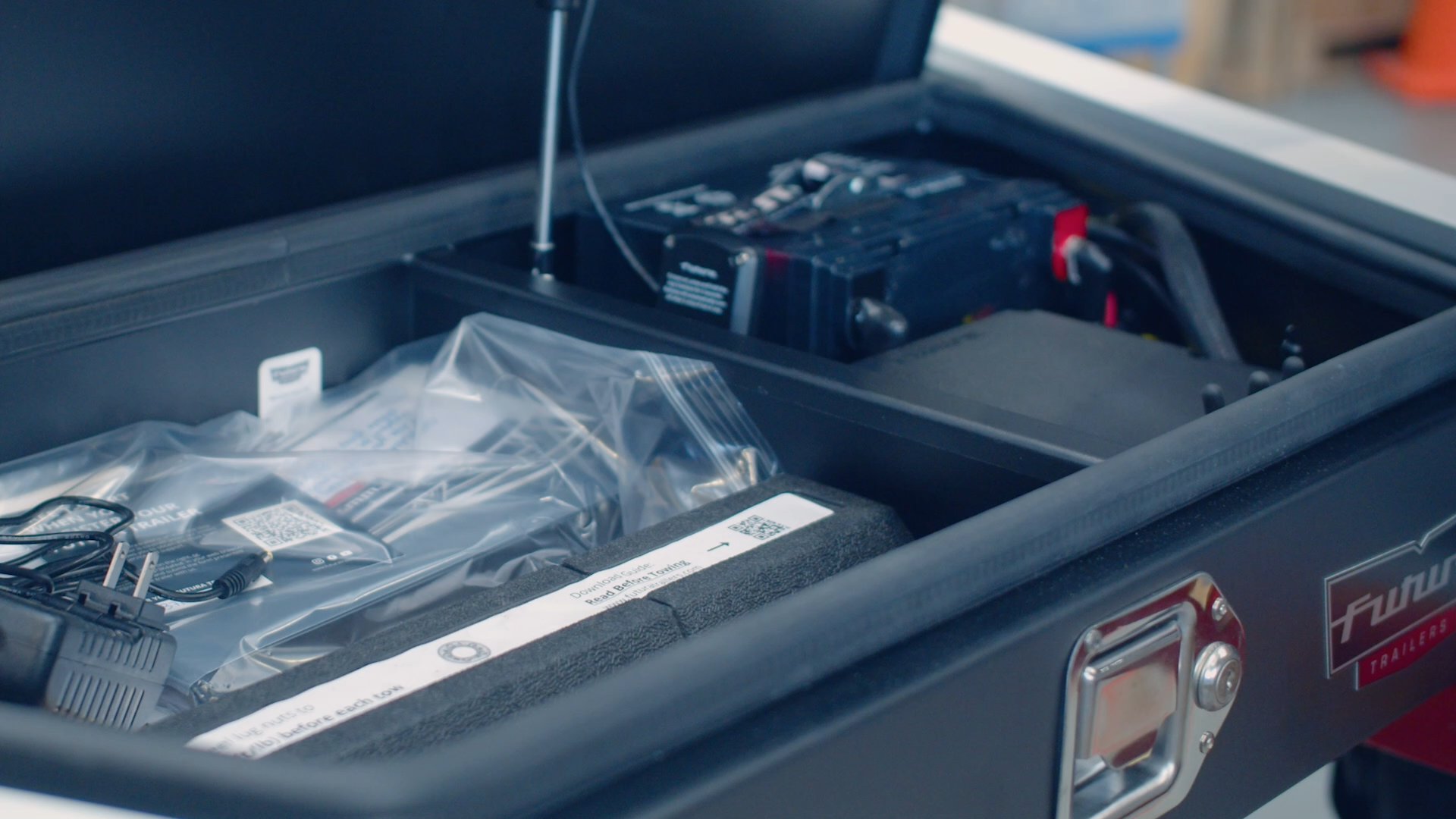Is your Futura Trailer Battery flat?
If the Futura lowering trailer will not raise it, could be that the battery is flat or has a defective cell.

- A healthy battery, when charged overnight, should reach a state of charge of at least 12.4V. If it doesn’t, the battery is too sulphated and needs to be replaced.
- A battery with a dead cell may read above 12 volts yet not have the power to run the winch.
- If the battery reads 0V, it has an internal short circuit.
Note that some smart chargers refuse to charge an otherwise healthy battery that’s been left drained overnight. A completely drained battery has not necessarily gone bad as long as you make sure to charge it immediately.
1. Check for Lose Battery Terminals
The battery terminals should not show movement when you (gently) wiggle the wires.
While not very common, battery terminals may come loose from hard impacts or excessive vibration.
2. Check the Onboard Battery Charger
Check 3 Amp fuses on the supply feed and output side of the onboard battery charger.
US models - Check the onboard chargers voltage input connection at the trailer's 7-way plug (the AUX pin)
Note: on NZ and AU models the trailer running lights must be on for the battery charger to receive input voltage and function.
The solar charger will take a long time to bring a flat battery up to full charge, the solar panel is designed to maintain the battery at the charge it was left at and not let it drop over time, if the panel has sufficient sunlight on it.
If you suspect the onboard battery charger is not working then try to charge the battery with an external battery charger such as a CTEK Multi US 3300 12-Volt Universal Battery Charger.
To connect an external battery charger without removing the battery from the Gen3 lowering trailer follow this guide.
3. The Battery Won’t Hold a Charge
Often, you will find that a battery you suspect has gone bad seems to charge as normal but loses its charge after just a day or two. A bad battery can lose its charge even when disconnected from the trailer.
When a battery has finished charging, it holds a higher but temporary surface charge that goes away after a couple of hours. When you read the voltage, it may indicate a healthy level above 12.4V. But after a day or two just sitting on the bench, a rapid self-discharge rate may have caused the voltage to drop well below your previous reading.
When a sealed battery no longer holds a charge, it has likely gone beyond repair and needs replacement.
4. Check for Bulging Battery Casing
Overcharging is when a battery is charged at too high of a voltage and can cause permanent damage to the battery. Typical signs of overcharging are when the batter loses its capacity, and the outer casing looks bloated with bulging sidewalls.
Bulging battery sidewalls are a sure sign it needs replacing, but you also need to find the source of the overcharging condition.
Using the wrong charger or wrong charge mode for the battery type can cause overcharge, but so can a defective voltage regulator.
If you require additional support, please get in touch with the Futura team directly, and we will gladly assist you in resolving the matter.
More Technical Info on Batteries
12.6 volts is the standard for an automobile battery such as the one installed on your Futura trailer.
Each battery has six cells with 2.1 voltage. When the battery is fully charged, this equals to 12.6 volts of charge in the battery.
If the voltage in a battery drops, even that 0.6 down to 12.0, there’s a 75% difference in power. The power drops down from 100% to 25%.
At 12.4 volts, the car battery is charged to 75%, and 12.2 means the voltage is at 50% charged. That means you can consider your battery charged if it is 12.4 volts or higher but discharged and in need of charging again if it’s even 12.39 volts or lower.
13.5 to 14.5 volts or more should register while the charging occurs. If it is not producing this, the charger may be having issues and needs to be tested.
Why Do Vehicle Batteries Go Bad?
While some vehicle batteries go bad from overcharging, physical damage, high temperatures, or short circuits, the number one cause is an internal chemical process known as sulfation.
When a battery discharges, the chemical reaction that happens inside the battery creates a by-product known as sulphate (salts of sulfuric acid). The build-up of sulphate salts on the lead plates is called battery sulfation.
Charging the battery naturally reverses the sulfation process by turning most sulphate salts or crystals back into electrolytes (battery acid).
But some sulphate salt crystals remain on the lead plates, and as the battery ages, they begin to build up.
The battery gradually loses some of its capacity (its potential to reach a full charge) as the sulphate crystals increase in size and harden on the lead plates. The sulfation also increases the battery rate of self-discharge.
Sulfation can be kept at a minimum by ensuring the battery stays at full charge most of the time.
The sulfation process accelerates when a battery sits at a drained or low state of charge for extended periods, such as through winter storage.
That is why your best hedge against a bad battery is to leave it on a maintenance charge throughout winter storage and to top it off now and then through the racing season.
Other Resources
Loading articles
